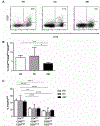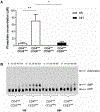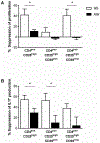Dysfunctional CD39(POS) regulatory T cells and aberrant control of T-helper type 17 cells in autoimmune hepatitis
- PMID: 23787765
- PMCID: PMC6377365
- DOI: 10.1002/hep.26583
Dysfunctional CD39(POS) regulatory T cells and aberrant control of T-helper type 17 cells in autoimmune hepatitis
Abstract
Autoimmune hepatitis (AIH) is an important cause of severe liver disease and is associated with both quantitative and qualitative regulatory T-cell (Treg) impairments. Tregs express CD39, an ectonucleotidase responsible for extracellular nucleotide hydrolysis, culminating in the production of immunosuppressive adenosine. Here, we describe multiple CD39(pos) Treg defects that potentially contribute to the impaired immunoregulation that is characteristic of AIH. We have examined the frequency and phenotype of CD39(pos) Tregs by flow cytometry and measured their ectonucleotidase activity. The capacity of CD4(pos) CD25(high) , CD4(pos) CD25(high) CD39(pos) , and CD4(pos) CD25(high) CD39(neg) subsets to suppress both proliferation of effector T cells and interleukin (IL)-17 production was evaluated. In AIH, CD39(pos) Tregs are decreased in frequency, exhibit limited adenosine triphosphate/adenosine diphosphate hydrolysis activity, and fail to suppress IL-17 production by effector CD4 T cells. Moreover, these CD39(pos) Tregs display a more proinflammatory profile in AIH, which is characterized by elevated CD127 positivity, and a greater propensity to produce interferon-gamma or IL-17 upon challenge with proinflammatory stimuli.
Conclusions: In AIH, CD39(pos) Tregs are decreased in number, fail to adequately hydrolyze proinflammatory nucleotides and do not efficiently suppress IL-17 production by effector CD4 T cells. CD39(pos) Tregs show plasticity and are unstable upon proinflammatory challenge, suggesting that defective immunoregulation in AIH might result not only from reduced Treg number and function, but also from increased conversion of Tregs into effector cells.
© 2014 by the American Association for the Study of Liver Diseases.
Figures




Comment in
-
Autoimmune hepatitis: 50 Years of (slow) progress.Hepatology. 2014 Mar;59(3):754-6. doi: 10.1002/hep.26682. Hepatology. 2014. PMID: 24712041 Free PMC article. No abstract available.
-
Reply: To PMID 23787765.Hepatology. 2015 Feb;61(2):737-8. doi: 10.1002/hep.27309. Epub 2015 Jan 5. Hepatology. 2015. PMID: 25042541 Free PMC article. No abstract available.
-
Phenotypic alterations of regulatory T cells in autoimmune hepatitis: causal or associated with treatment and remission?Hepatology. 2015 Feb;61(2):736-7. doi: 10.1002/hep.27301. Epub 2015 Jan 5. Hepatology. 2015. PMID: 25044332 No abstract available.
References
-
- Longhi MS, Ma Y, Mieli-Vergani G, Vergani D. Aetiopathogenesis of autoimmune hepatitis. J Autoimmun 2010;34:7–14. - PubMed
-
- Gregorio GV, Portmann B, Reid F, Donaldson PT, Doherty DG, McCartney M, Mowat AP, et al. Autoimmune hepatitis in childhood: a 20-year experience. Hepatology 1997;25:541–547. - PubMed
-
- Longhi MS, Ma Y, Bogdanos DP, Cheeseman P, Mieli-Vergani G, Vergani D. Impairment of CD4(+)CD25(+) regulatory T-cells in autoimmune liver disease. J Hepatol 2004;41:31–37. - PubMed
-
- Ferri S, Longhi MS, De Molo C, Lalanne C, Muratori P, Granito A, Hussain MJ, et al. A multifaceted imbalance of T cells with regulatory function characterizes type 1 autoimmune hepatitis. Hepatology 2010;52:999–1007. - PubMed
-
- Longhi MS, Hussain MJ, Kwok WW, Mieli-Vergani G, Ma Y, Vergani D. Autoantigen-specific regulatory T cells, a potential tool for immune-tolerance reconstitution in type-2 autoimmune hepatitis. Hepatology 2011;53:536–547. - PubMed
Publication types
MeSH terms
Substances
Grants and funding
LinkOut - more resources
Full Text Sources
Other Literature Sources
Research Materials
